ER1030 Engineering Science: Automobile Body Material Analysis Report
VerifiedAdded on 2023/06/15
|9
|1546
|374
Report
AI Summary
This report provides a detailed analysis of the materials used in automobile bodies, focusing primarily on steel and its properties. It discusses the mechanical and physical characteristics essential for car body materials, such as strength, mechanical resistance, flexibility, and corrosion resistance. The report delves into the microstructure of metals, emphasizing the crystalline structure and how it influences material properties. Heat treatment processes for steel are explained, highlighting their importance in achieving the required strength and shape. Furthermore, the report covers thermal properties like the coefficient of thermal expansion, thermal conductivity, heat capacity, and heat of fusion. The manufacturing process of car body parts is outlined, including material selection, casting, formation technologies, joining, and prototyping. The report also touches on the environmental impact of steel and explores alternative materials like aluminum, plastics, fiberglass, and carbon. The assignment is for the course Engineering Science ER1030.

1 | P a g e
Name:
Course:
Professor:
Date:
Name:
Course:
Professor:
Date:
Paraphrase This Document
Need a fresh take? Get an instant paraphrase of this document with our AI Paraphraser
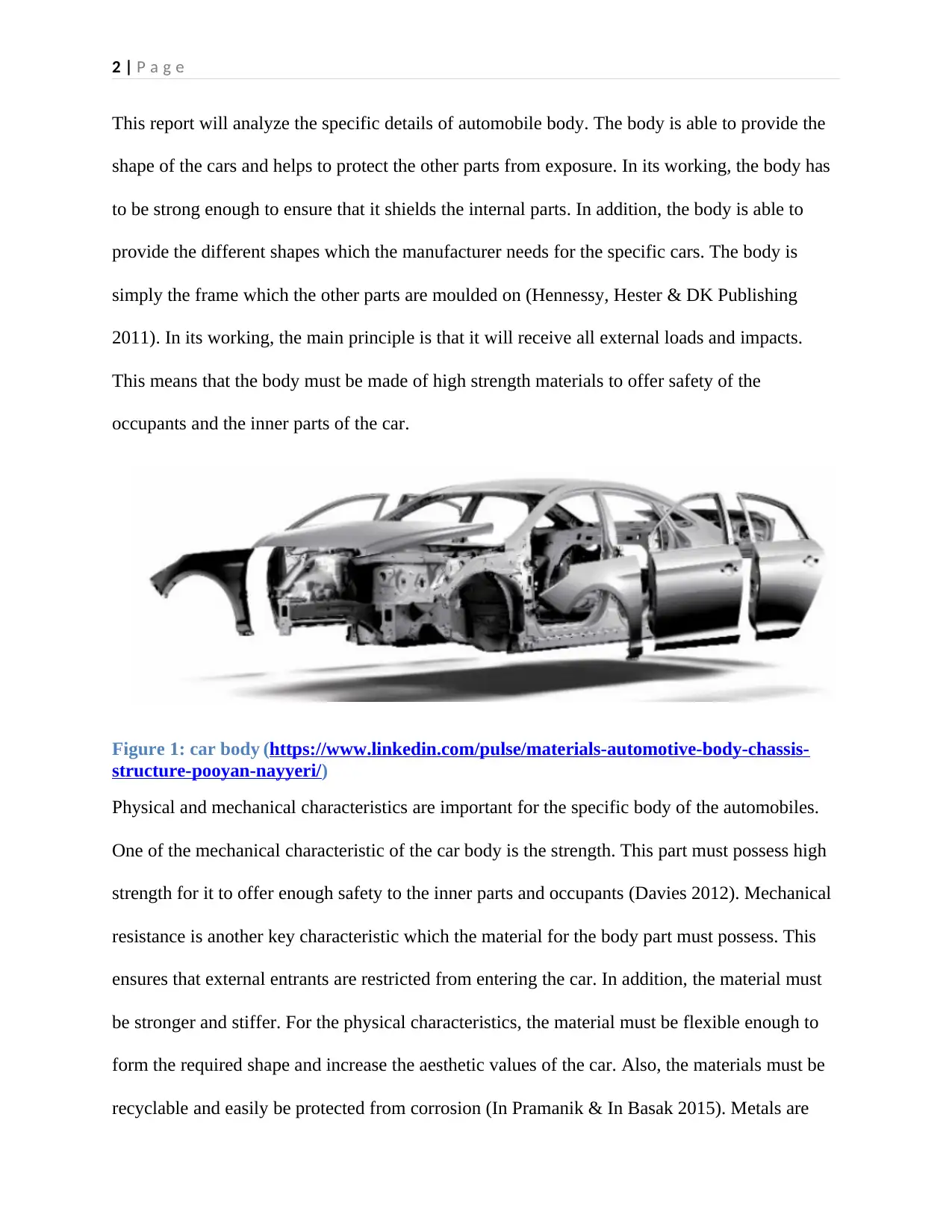
2 | P a g e
This report will analyze the specific details of automobile body. The body is able to provide the
shape of the cars and helps to protect the other parts from exposure. In its working, the body has
to be strong enough to ensure that it shields the internal parts. In addition, the body is able to
provide the different shapes which the manufacturer needs for the specific cars. The body is
simply the frame which the other parts are moulded on (Hennessy, Hester & DK Publishing
2011). In its working, the main principle is that it will receive all external loads and impacts.
This means that the body must be made of high strength materials to offer safety of the
occupants and the inner parts of the car.
Figure 1: car body (https://www.linkedin.com/pulse/materials-automotive-body-chassis-
structure-pooyan-nayyeri/)
Physical and mechanical characteristics are important for the specific body of the automobiles.
One of the mechanical characteristic of the car body is the strength. This part must possess high
strength for it to offer enough safety to the inner parts and occupants (Davies 2012). Mechanical
resistance is another key characteristic which the material for the body part must possess. This
ensures that external entrants are restricted from entering the car. In addition, the material must
be stronger and stiffer. For the physical characteristics, the material must be flexible enough to
form the required shape and increase the aesthetic values of the car. Also, the materials must be
recyclable and easily be protected from corrosion (In Pramanik & In Basak 2015). Metals are
This report will analyze the specific details of automobile body. The body is able to provide the
shape of the cars and helps to protect the other parts from exposure. In its working, the body has
to be strong enough to ensure that it shields the internal parts. In addition, the body is able to
provide the different shapes which the manufacturer needs for the specific cars. The body is
simply the frame which the other parts are moulded on (Hennessy, Hester & DK Publishing
2011). In its working, the main principle is that it will receive all external loads and impacts.
This means that the body must be made of high strength materials to offer safety of the
occupants and the inner parts of the car.
Figure 1: car body (https://www.linkedin.com/pulse/materials-automotive-body-chassis-
structure-pooyan-nayyeri/)
Physical and mechanical characteristics are important for the specific body of the automobiles.
One of the mechanical characteristic of the car body is the strength. This part must possess high
strength for it to offer enough safety to the inner parts and occupants (Davies 2012). Mechanical
resistance is another key characteristic which the material for the body part must possess. This
ensures that external entrants are restricted from entering the car. In addition, the material must
be stronger and stiffer. For the physical characteristics, the material must be flexible enough to
form the required shape and increase the aesthetic values of the car. Also, the materials must be
recyclable and easily be protected from corrosion (In Pramanik & In Basak 2015). Metals are
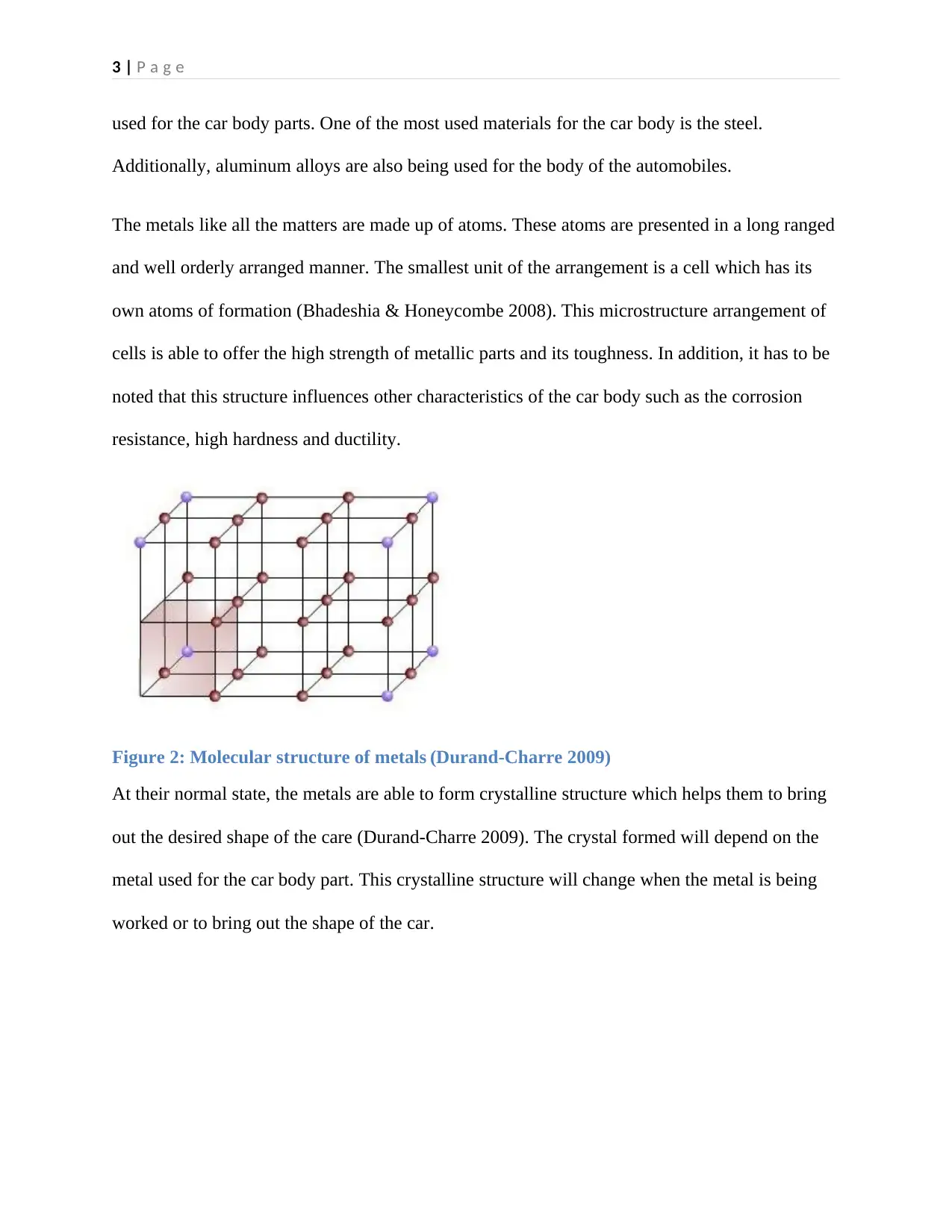
3 | P a g e
used for the car body parts. One of the most used materials for the car body is the steel.
Additionally, aluminum alloys are also being used for the body of the automobiles.
The metals like all the matters are made up of atoms. These atoms are presented in a long ranged
and well orderly arranged manner. The smallest unit of the arrangement is a cell which has its
own atoms of formation (Bhadeshia & Honeycombe 2008). This microstructure arrangement of
cells is able to offer the high strength of metallic parts and its toughness. In addition, it has to be
noted that this structure influences other characteristics of the car body such as the corrosion
resistance, high hardness and ductility.
Figure 2: Molecular structure of metals (Durand-Charre 2009)
At their normal state, the metals are able to form crystalline structure which helps them to bring
out the desired shape of the care (Durand-Charre 2009). The crystal formed will depend on the
metal used for the car body part. This crystalline structure will change when the metal is being
worked or to bring out the shape of the car.
used for the car body parts. One of the most used materials for the car body is the steel.
Additionally, aluminum alloys are also being used for the body of the automobiles.
The metals like all the matters are made up of atoms. These atoms are presented in a long ranged
and well orderly arranged manner. The smallest unit of the arrangement is a cell which has its
own atoms of formation (Bhadeshia & Honeycombe 2008). This microstructure arrangement of
cells is able to offer the high strength of metallic parts and its toughness. In addition, it has to be
noted that this structure influences other characteristics of the car body such as the corrosion
resistance, high hardness and ductility.
Figure 2: Molecular structure of metals (Durand-Charre 2009)
At their normal state, the metals are able to form crystalline structure which helps them to bring
out the desired shape of the care (Durand-Charre 2009). The crystal formed will depend on the
metal used for the car body part. This crystalline structure will change when the metal is being
worked or to bring out the shape of the car.
⊘ This is a preview!⊘
Do you want full access?
Subscribe today to unlock all pages.

Trusted by 1+ million students worldwide
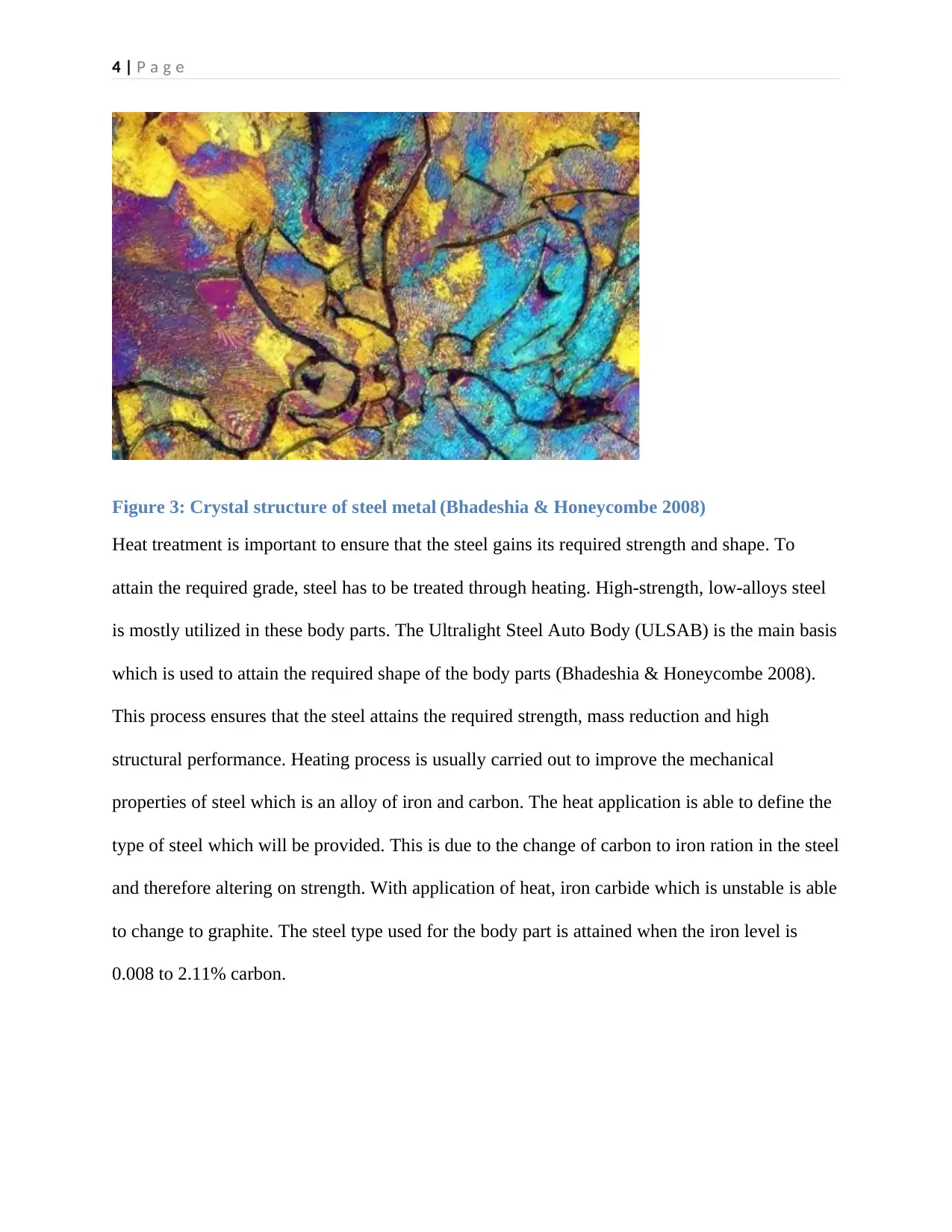
4 | P a g e
Figure 3: Crystal structure of steel metal (Bhadeshia & Honeycombe 2008)
Heat treatment is important to ensure that the steel gains its required strength and shape. To
attain the required grade, steel has to be treated through heating. High-strength, low-alloys steel
is mostly utilized in these body parts. The Ultralight Steel Auto Body (ULSAB) is the main basis
which is used to attain the required shape of the body parts (Bhadeshia & Honeycombe 2008).
This process ensures that the steel attains the required strength, mass reduction and high
structural performance. Heating process is usually carried out to improve the mechanical
properties of steel which is an alloy of iron and carbon. The heat application is able to define the
type of steel which will be provided. This is due to the change of carbon to iron ration in the steel
and therefore altering on strength. With application of heat, iron carbide which is unstable is able
to change to graphite. The steel type used for the body part is attained when the iron level is
0.008 to 2.11% carbon.
Figure 3: Crystal structure of steel metal (Bhadeshia & Honeycombe 2008)
Heat treatment is important to ensure that the steel gains its required strength and shape. To
attain the required grade, steel has to be treated through heating. High-strength, low-alloys steel
is mostly utilized in these body parts. The Ultralight Steel Auto Body (ULSAB) is the main basis
which is used to attain the required shape of the body parts (Bhadeshia & Honeycombe 2008).
This process ensures that the steel attains the required strength, mass reduction and high
structural performance. Heating process is usually carried out to improve the mechanical
properties of steel which is an alloy of iron and carbon. The heat application is able to define the
type of steel which will be provided. This is due to the change of carbon to iron ration in the steel
and therefore altering on strength. With application of heat, iron carbide which is unstable is able
to change to graphite. The steel type used for the body part is attained when the iron level is
0.008 to 2.11% carbon.
Paraphrase This Document
Need a fresh take? Get an instant paraphrase of this document with our AI Paraphraser
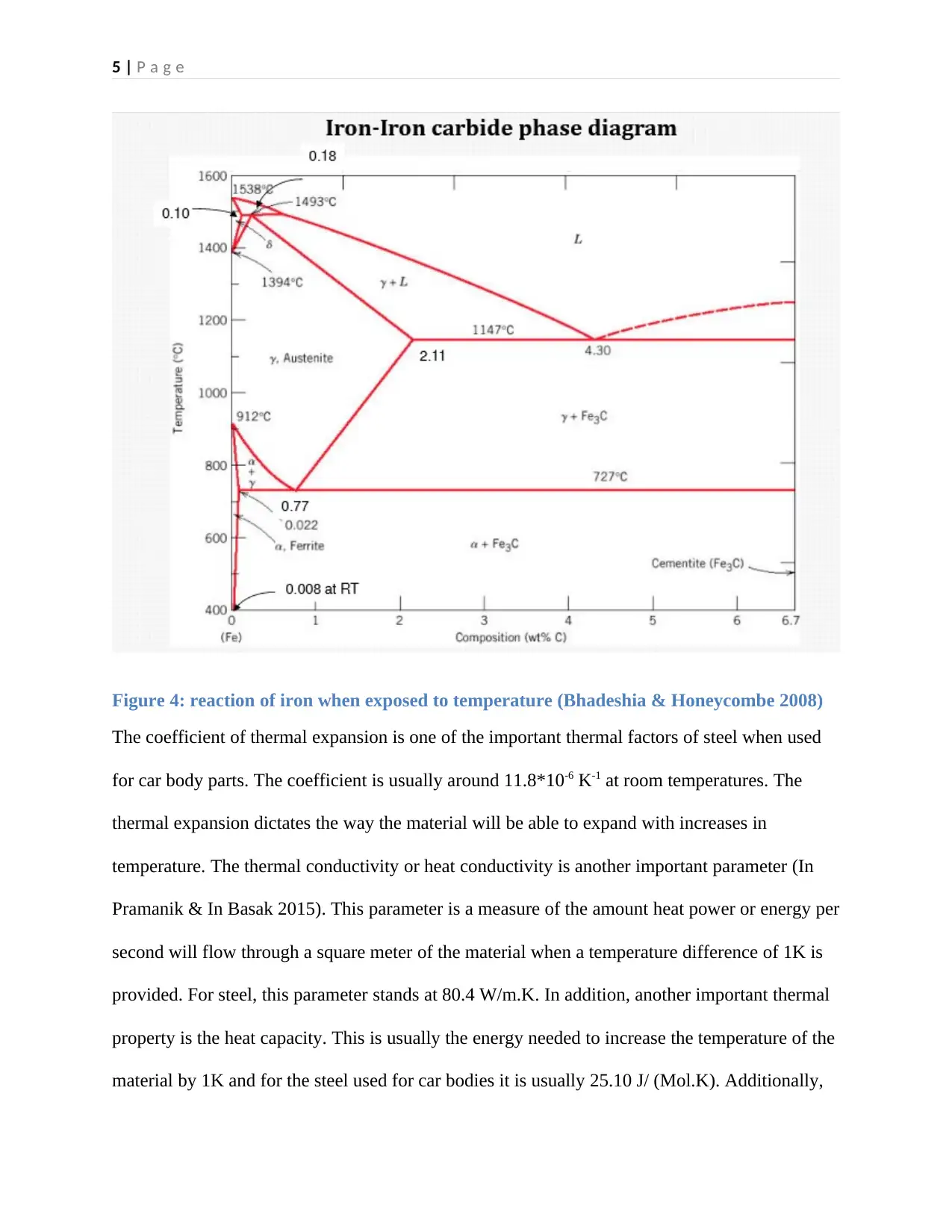
5 | P a g e
Figure 4: reaction of iron when exposed to temperature (Bhadeshia & Honeycombe 2008)
The coefficient of thermal expansion is one of the important thermal factors of steel when used
for car body parts. The coefficient is usually around 11.8*10-6 K-1 at room temperatures. The
thermal expansion dictates the way the material will be able to expand with increases in
temperature. The thermal conductivity or heat conductivity is another important parameter (In
Pramanik & In Basak 2015). This parameter is a measure of the amount heat power or energy per
second will flow through a square meter of the material when a temperature difference of 1K is
provided. For steel, this parameter stands at 80.4 W/m.K. In addition, another important thermal
property is the heat capacity. This is usually the energy needed to increase the temperature of the
material by 1K and for the steel used for car bodies it is usually 25.10 J/ (Mol.K). Additionally,
Figure 4: reaction of iron when exposed to temperature (Bhadeshia & Honeycombe 2008)
The coefficient of thermal expansion is one of the important thermal factors of steel when used
for car body parts. The coefficient is usually around 11.8*10-6 K-1 at room temperatures. The
thermal expansion dictates the way the material will be able to expand with increases in
temperature. The thermal conductivity or heat conductivity is another important parameter (In
Pramanik & In Basak 2015). This parameter is a measure of the amount heat power or energy per
second will flow through a square meter of the material when a temperature difference of 1K is
provided. For steel, this parameter stands at 80.4 W/m.K. In addition, another important thermal
property is the heat capacity. This is usually the energy needed to increase the temperature of the
material by 1K and for the steel used for car bodies it is usually 25.10 J/ (Mol.K). Additionally,
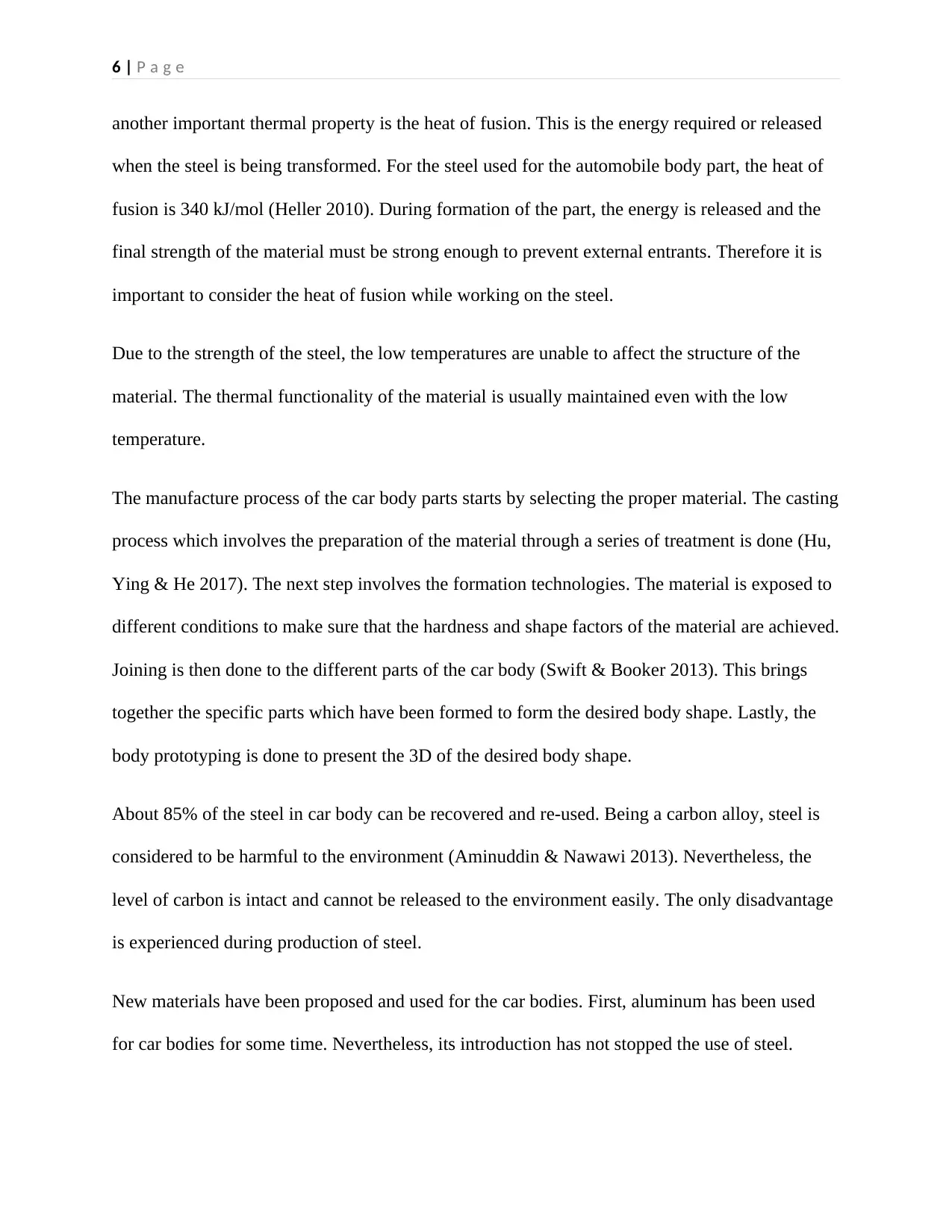
6 | P a g e
another important thermal property is the heat of fusion. This is the energy required or released
when the steel is being transformed. For the steel used for the automobile body part, the heat of
fusion is 340 kJ/mol (Heller 2010). During formation of the part, the energy is released and the
final strength of the material must be strong enough to prevent external entrants. Therefore it is
important to consider the heat of fusion while working on the steel.
Due to the strength of the steel, the low temperatures are unable to affect the structure of the
material. The thermal functionality of the material is usually maintained even with the low
temperature.
The manufacture process of the car body parts starts by selecting the proper material. The casting
process which involves the preparation of the material through a series of treatment is done (Hu,
Ying & He 2017). The next step involves the formation technologies. The material is exposed to
different conditions to make sure that the hardness and shape factors of the material are achieved.
Joining is then done to the different parts of the car body (Swift & Booker 2013). This brings
together the specific parts which have been formed to form the desired body shape. Lastly, the
body prototyping is done to present the 3D of the desired body shape.
About 85% of the steel in car body can be recovered and re-used. Being a carbon alloy, steel is
considered to be harmful to the environment (Aminuddin & Nawawi 2013). Nevertheless, the
level of carbon is intact and cannot be released to the environment easily. The only disadvantage
is experienced during production of steel.
New materials have been proposed and used for the car bodies. First, aluminum has been used
for car bodies for some time. Nevertheless, its introduction has not stopped the use of steel.
another important thermal property is the heat of fusion. This is the energy required or released
when the steel is being transformed. For the steel used for the automobile body part, the heat of
fusion is 340 kJ/mol (Heller 2010). During formation of the part, the energy is released and the
final strength of the material must be strong enough to prevent external entrants. Therefore it is
important to consider the heat of fusion while working on the steel.
Due to the strength of the steel, the low temperatures are unable to affect the structure of the
material. The thermal functionality of the material is usually maintained even with the low
temperature.
The manufacture process of the car body parts starts by selecting the proper material. The casting
process which involves the preparation of the material through a series of treatment is done (Hu,
Ying & He 2017). The next step involves the formation technologies. The material is exposed to
different conditions to make sure that the hardness and shape factors of the material are achieved.
Joining is then done to the different parts of the car body (Swift & Booker 2013). This brings
together the specific parts which have been formed to form the desired body shape. Lastly, the
body prototyping is done to present the 3D of the desired body shape.
About 85% of the steel in car body can be recovered and re-used. Being a carbon alloy, steel is
considered to be harmful to the environment (Aminuddin & Nawawi 2013). Nevertheless, the
level of carbon is intact and cannot be released to the environment easily. The only disadvantage
is experienced during production of steel.
New materials have been proposed and used for the car bodies. First, aluminum has been used
for car bodies for some time. Nevertheless, its introduction has not stopped the use of steel.
⊘ This is a preview!⊘
Do you want full access?
Subscribe today to unlock all pages.

Trusted by 1+ million students worldwide

7 | P a g e
Other materials are being analyzed to achieve reduced car weight to ensure low energy
consumption. Plastics, fiberglass and carbon are being investigated to be used.
Other materials are being analyzed to achieve reduced car weight to ensure low energy
consumption. Plastics, fiberglass and carbon are being investigated to be used.
Paraphrase This Document
Need a fresh take? Get an instant paraphrase of this document with our AI Paraphraser
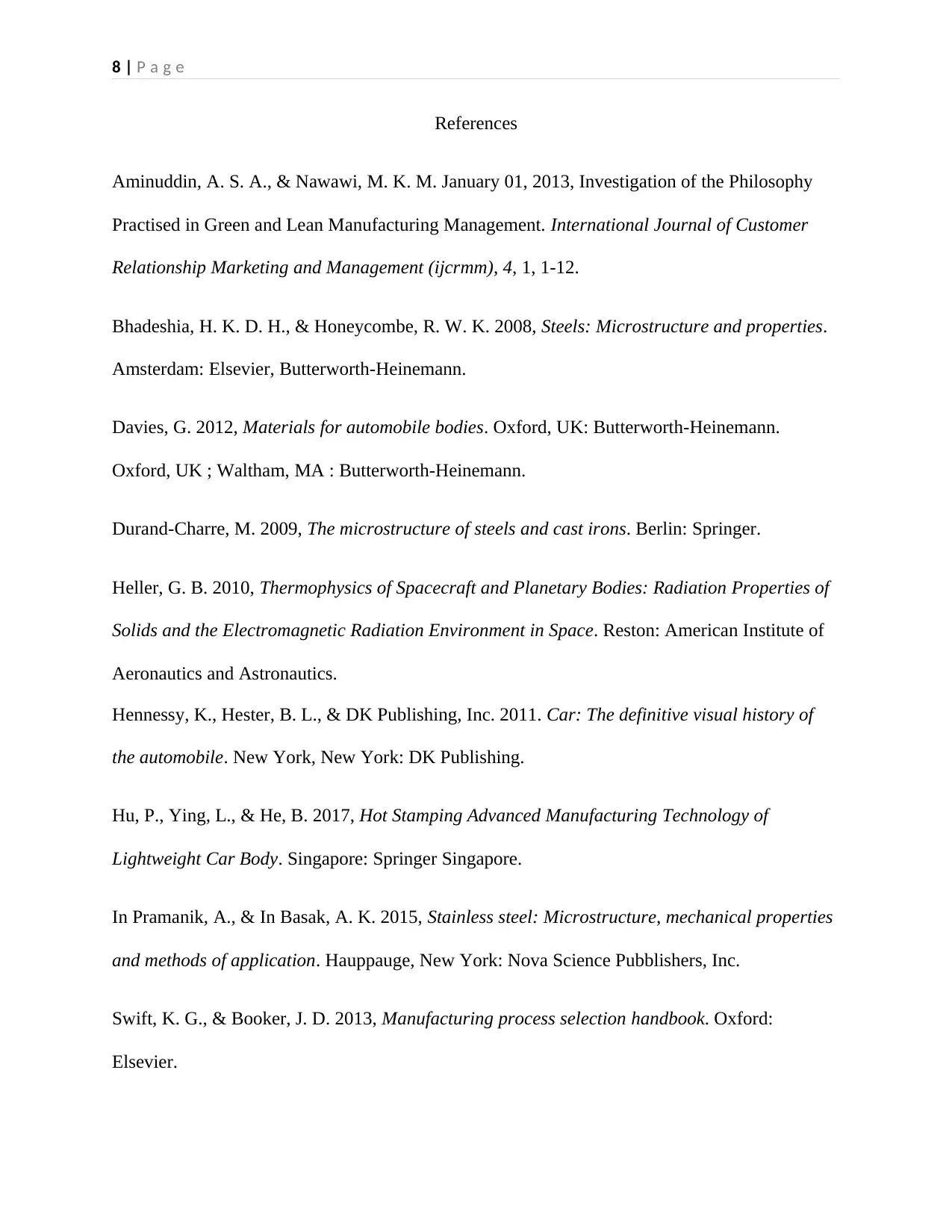
8 | P a g e
References
Aminuddin, A. S. A., & Nawawi, M. K. M. January 01, 2013, Investigation of the Philosophy
Practised in Green and Lean Manufacturing Management. International Journal of Customer
Relationship Marketing and Management (ijcrmm), 4, 1, 1-12.
Bhadeshia, H. K. D. H., & Honeycombe, R. W. K. 2008, Steels: Microstructure and properties.
Amsterdam: Elsevier, Butterworth-Heinemann.
Davies, G. 2012, Materials for automobile bodies. Oxford, UK: Butterworth-Heinemann.
Oxford, UK ; Waltham, MA : Butterworth-Heinemann.
Durand-Charre, M. 2009, The microstructure of steels and cast irons. Berlin: Springer.
Heller, G. B. 2010, Thermophysics of Spacecraft and Planetary Bodies: Radiation Properties of
Solids and the Electromagnetic Radiation Environment in Space. Reston: American Institute of
Aeronautics and Astronautics.
Hennessy, K., Hester, B. L., & DK Publishing, Inc. 2011. Car: The definitive visual history of
the automobile. New York, New York: DK Publishing.
Hu, P., Ying, L., & He, B. 2017, Hot Stamping Advanced Manufacturing Technology of
Lightweight Car Body. Singapore: Springer Singapore.
In Pramanik, A., & In Basak, A. K. 2015, Stainless steel: Microstructure, mechanical properties
and methods of application. Hauppauge, New York: Nova Science Pubblishers, Inc.
Swift, K. G., & Booker, J. D. 2013, Manufacturing process selection handbook. Oxford:
Elsevier.
References
Aminuddin, A. S. A., & Nawawi, M. K. M. January 01, 2013, Investigation of the Philosophy
Practised in Green and Lean Manufacturing Management. International Journal of Customer
Relationship Marketing and Management (ijcrmm), 4, 1, 1-12.
Bhadeshia, H. K. D. H., & Honeycombe, R. W. K. 2008, Steels: Microstructure and properties.
Amsterdam: Elsevier, Butterworth-Heinemann.
Davies, G. 2012, Materials for automobile bodies. Oxford, UK: Butterworth-Heinemann.
Oxford, UK ; Waltham, MA : Butterworth-Heinemann.
Durand-Charre, M. 2009, The microstructure of steels and cast irons. Berlin: Springer.
Heller, G. B. 2010, Thermophysics of Spacecraft and Planetary Bodies: Radiation Properties of
Solids and the Electromagnetic Radiation Environment in Space. Reston: American Institute of
Aeronautics and Astronautics.
Hennessy, K., Hester, B. L., & DK Publishing, Inc. 2011. Car: The definitive visual history of
the automobile. New York, New York: DK Publishing.
Hu, P., Ying, L., & He, B. 2017, Hot Stamping Advanced Manufacturing Technology of
Lightweight Car Body. Singapore: Springer Singapore.
In Pramanik, A., & In Basak, A. K. 2015, Stainless steel: Microstructure, mechanical properties
and methods of application. Hauppauge, New York: Nova Science Pubblishers, Inc.
Swift, K. G., & Booker, J. D. 2013, Manufacturing process selection handbook. Oxford:
Elsevier.

9 | P a g e
https://www.linkedin.com/pulse/materials-automotive-body-chassis-structure-pooyan-nayyeri/
https://www.linkedin.com/pulse/materials-automotive-body-chassis-structure-pooyan-nayyeri/
⊘ This is a preview!⊘
Do you want full access?
Subscribe today to unlock all pages.

Trusted by 1+ million students worldwide
1 out of 9
Related Documents
Your All-in-One AI-Powered Toolkit for Academic Success.
+13062052269
info@desklib.com
Available 24*7 on WhatsApp / Email
![[object Object]](/_next/static/media/star-bottom.7253800d.svg)
Unlock your academic potential
© 2024 | Zucol Services PVT LTD | All rights reserved.





